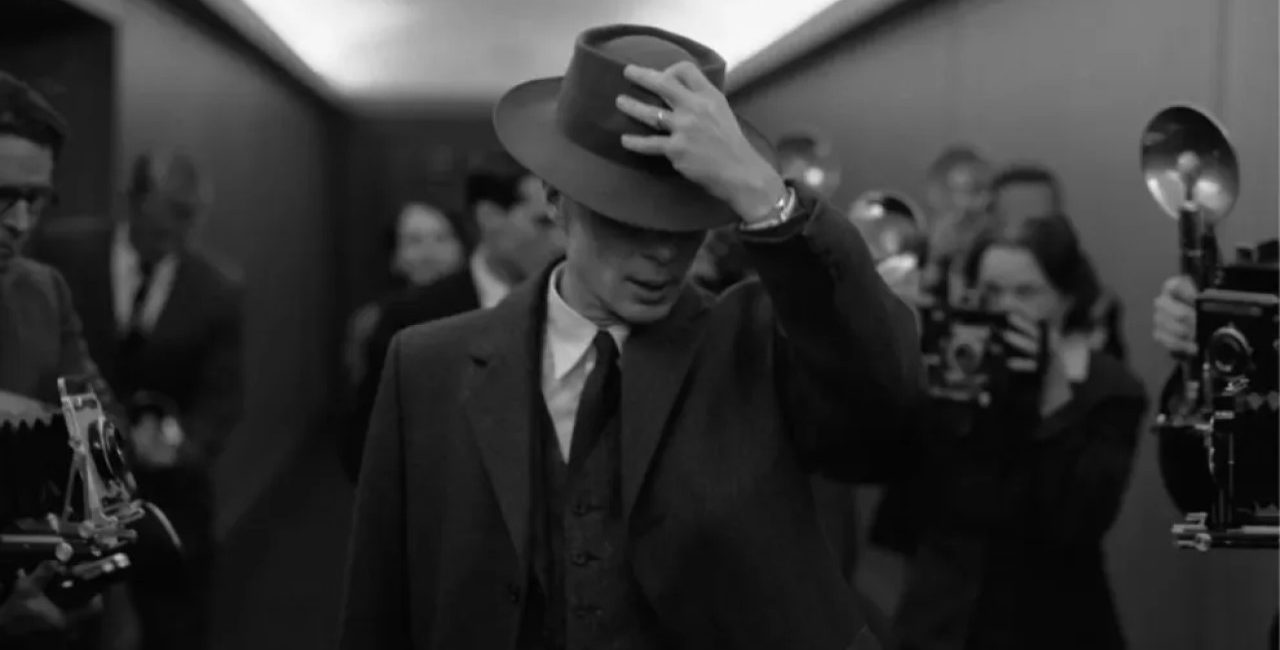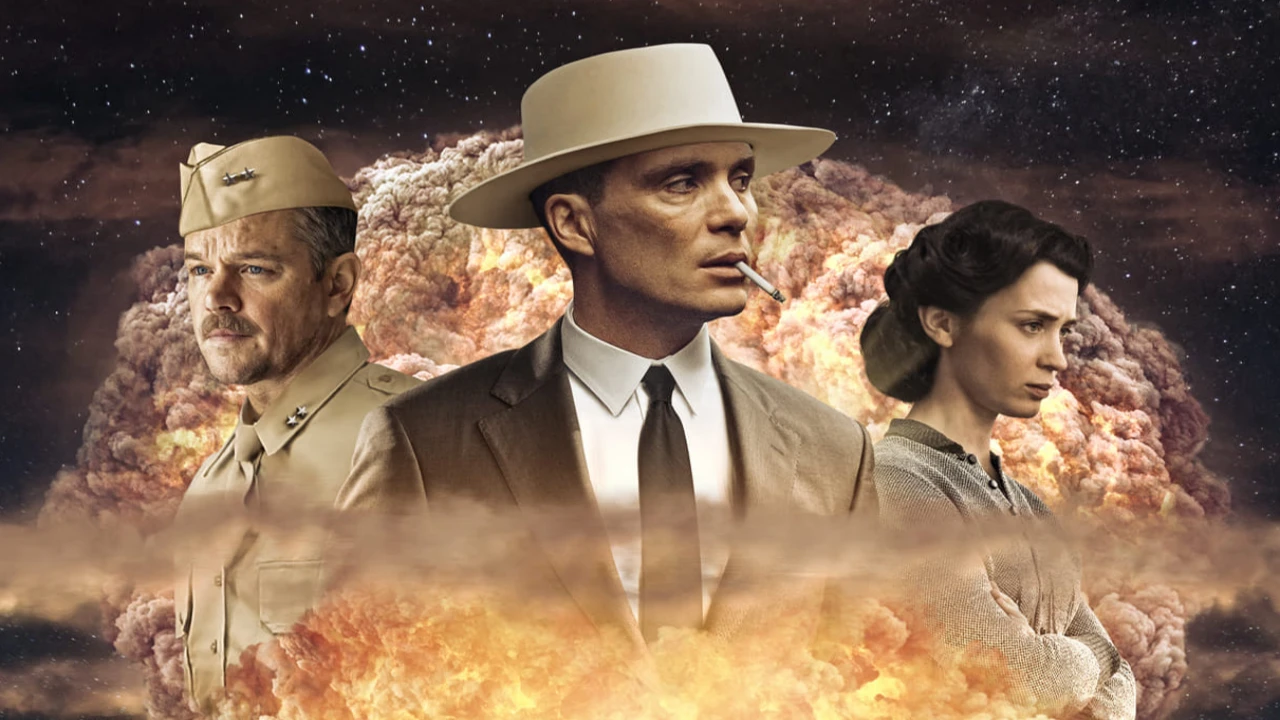Christopher Nolan’s Oppenheimer (2023) is not simply a biopic—it is an intellectual firestorm, a meditation on genius, guilt, and the haunting consequences of ambition. With a powerful script, a towering performance by Cillian Murphy, and a relentless narrative structure that shifts across time and moral dimension, the film grips you not with action, but with gravity.
Adapted from the Pulitzer Prize–winning biography American Prometheus by Kai Bird and Martin J. Sherwin, Oppenheimer charts the life of theoretical physicist J. Robert Oppenheimer, the father of the atomic bomb. But Nolan, ever the formal experimenter, doesn’t tell this story chronologically. Instead, the film oscillates between timelines: the feverish build-up to the Trinity Test; Oppenheimer’s moral reckoning in the post-war years; and a grueling political inquisition that attempts to dismantle not just his career, but his conscience.

A Mind at War
At the heart of the film is Murphy’s portrayal of Oppenheimer—a man both brilliant and broken. With sunken eyes, hollow cheeks, and a voice that seems to echo from some interior void, Murphy captures a man seduced by theory and haunted by consequence. He is a scientist who wanted to understand the stars, but instead brought fire to the earth.
The supporting cast is equally impressive. Emily Blunt gives a steely performance as Kitty Oppenheimer, whose rage simmers beneath years of standing in her husband’s intellectual shadow. Robert Downey Jr. disappears into the role of Lewis Strauss, a bureaucrat whose smiling ambition eventually becomes venomous. Florence Pugh’s Jean Tatlock, though only on screen briefly, haunts Oppenheimer’s psyche like a ghost of passion and political vulnerability.
But Oppenheimer isn’t just about performances—it’s about ideas, and the tension between them. Nolan’s screenplay, dense and layered, explores not only the race to build the bomb but the ethical, political, and emotional detritus left in its wake. Oppenheimer’s belief that building the bomb would stop the war quickly curdles into horror once it’s used—not as deterrent, but as devastation.

Cinematic Detonation
Visually, the film is one of Nolan’s most restrained and yet most precise. Shot in IMAX with both color and black-and-white film, cinematographer Hoyte van Hoytema gives Oppenheimer a tactile, almost documentary quality. There are no CGI mushroom clouds—instead, Nolan uses practical effects to simulate the Trinity Test, emphasizing light, sound, and the unbearable pause before the explosion.
That pause is emblematic of the film itself. The most chilling moment in Oppenheimer comes not during the test, but afterward, in a packed auditorium. Oppenheimer, lauded as a hero, stares blankly as the crowd erupts into applause. We hear cheering, but in his mind, it's replaced by screaming. The floor shakes. Light flashes. A girl’s face peels away like ash. It is a moment of total dissonance—he has split the atom, and with it, split his soul.
Composer Ludwig Göransson’s score is among the film’s secret weapons. Unlike Hans Zimmer’s bombast in Interstellar or Inception, Göransson’s music here is leaner, nervier—strings that fray, rhythms that build and then collapse. It pulses beneath the film like a countdown we’re trying to ignore.

Judgment and Fallout
Much of Oppenheimer takes place in confined rooms—hearings, interviews, interrogations. Nolan uses these moments not as detours, but as pressure chambers. The scenes of Oppenheimer being questioned about his ties to communism—largely a witch hunt driven by Cold War paranoia—become as tense as any action sequence.
The film ends not with victory, but with devastation. In the final moments, Einstein and Oppenheimer stand beside a lake. Oppenheimer recalls a past conversation, in which he feared the bomb might ignite the atmosphere and destroy the world. “I believe we did,” he says, not as a scientist, but as a prophet of ruin.
This closing line doesn't just conclude the film—it echoes forward. Nolan’s Oppenheimer is not just about the past; it is a warning to the future. The fire that Oppenheimer helped unleash is still with us—in nuclear arsenals, in ethical compromise, in the temptation to believe that intelligence is inherently righteous.

A Hypothetical Sequel: Teller
If Oppenheimer were to have a thematic sequel—not a direct continuation, but a spiritual companion—it might follow Edward Teller, the "father of the hydrogen bomb." A film titled Teller could explore how the Cold War escalated from the ashes of Hiroshima and Nagasaki into a new era of even greater existential peril.
Where Oppenheimer is about guilt and doubt, Teller could explore arrogance and ambition. Unlike Oppenheimer, Teller never flinched. He believed that bigger bombs equaled greater deterrence, and his lobbying for the hydrogen bomb changed the course of geopolitics. Such a film could examine not just the race for arms, but the race for influence in Washington, the ethical decay of the military-industrial complex, and how one man’s fear of communism shaped half a century of global tension.
It could mirror Oppenheimer’s structure—past and present converging—but with a colder tone. Teller’s relationship with Oppenheimer, once one of scientific brotherhood, soured into betrayal when Teller testified against him. Their rupture represents not just personal conflict, but a philosophical split: the scientist as seeker of truth vs. the scientist as servant of state.

This hypothetical sequel would not aim to top Oppenheimer in scale or spectacle—but rather to continue its examination of what happens when knowledge outpaces wisdom.
Oppenheimer is a triumph of modern cinema not because of how loud it is—but because of how deeply it listens. It listens to the heartbeat of genius, the whisper of fear, the silence after applause. It is a film that dares to ask uncomfortable questions: Can brilliance be separated from responsibility? Can creation exist without destruction? And what is the moral weight of a man who gives humanity the power to end itself?
In a world increasingly obsessed with immediacy and spectacle, Oppenheimer dares to be a slow burn. It asks us to sit with history—and with ourselves.
And when we do, we may find—as Oppenheimer did—that the real explosion was never in the desert.
It was in the mind.



